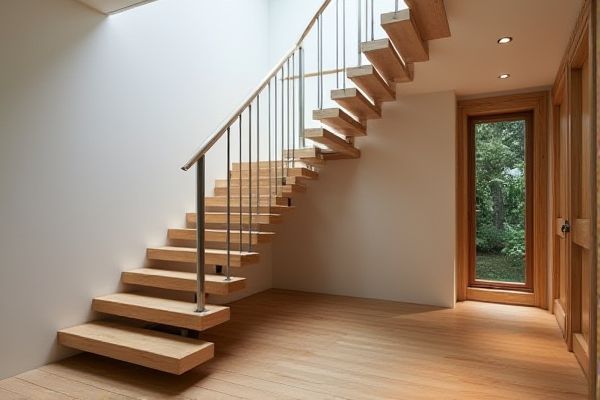
Floating treads create a minimalist look by appearing to hover without visible support, while cantilevered treads are anchored firmly into a wall, providing a sturdier feel and structural reliability. Explore the rest of the article to determine which stair design best suits your space and style preferences.
Table of Comparison
| Feature | Floating Treads | Cantilevered Treads |
|---|---|---|
| Design | Individual treads appear suspended with no visible support underneath | Treads anchored at one end, projecting from a wall or stringer |
| Support Mechanism | Hidden brackets or steel frame within the wall | Fixed into a structural wall or central support beam |
| Visual Appeal | Lightweight, open, modern aesthetic | Sleek, minimalist, dramatic cantilever effect |
| Installation Complexity | Moderate to high due to concealed supports | High, requires strong anchoring and precise engineering |
| Load Capacity | Good, depends on internal brackets and wall strength | Excellent, relies on wall or beam anchoring strength |
| Common Materials | Wood, glass, metal | Wood, steel, concrete |
| Cost | Moderate to high | High due to engineering and materials |
| Space Perception | Creates open, airy staircases that enhance space | Creates dramatic floating effect with focused support |
Introduction to Floating and Cantilevered Treads
Floating treads create an open, airy aesthetic by appearing to hover without visible supports, achieved through hidden brackets anchored into the wall. Cantilevered treads extend horizontally from a central support or wall, providing sturdy, minimalist steps with a sleek profile. Your choice between floating and cantilevered treads impacts both visual style and structural requirements in stair design.
Defining Floating Treads
Floating treads are staircase steps anchored only at one end, creating a minimalist, open appearance with no visible support underneath. Unlike cantilevered treads, which are embedded into a supporting wall or framework, floating treads rely on hidden brackets or steel supports for stability. Your choice between these designs impacts both aesthetic appeal and structural requirements in modern architectural spaces.
Understanding Cantilevered Treads
Cantilevered treads are fixed securely into a wall or beam on one side, creating a clean, minimalist appearance with no visible supports underneath, unlike floating treads that often rely on hidden brackets or cables. This structural method allows cantilevered stairs to convey a sense of openness and modern design by appearing to "float" while being anchored firmly to a load-bearing element. Understanding the engineering behind cantilevered treads is essential to ensure your staircase is both visually striking and structurally safe.
Key Design Differences
Floating treads are characterized by treads attached directly to a hidden stringer or wall without visible supports, creating a minimalist and airy appearance. Cantilevered treads project horizontally from a single anchored side, typically embedded into a structural wall or beam, offering a dramatic and sculptural look. The key design difference lies in support visibility and structural integration--floating treads rely on concealed mechanisms for an ultra-clean aesthetic, while cantilevered treads emphasize the robustness of one-sided anchoring for visual impact.
Material Options for Both Tread Types
Floating treads commonly use materials like wood, glass, and metal to achieve a sleek, minimalist look, while cantilevered treads often feature hardwood or engineered wood anchored securely into a wall for structural support. Both types can incorporate steel or aluminum for modern aesthetics and durability, but floating treads may also include tempered glass for transparency. Your choice of material impacts not only the visual appeal but also the installation complexity and maintenance requirements of these stair designs.
Structural Support and Safety
Floating treads rely on hidden steel brackets embedded in the wall for structural support, offering a sleek, minimalist appearance but requiring robust wall construction to ensure safety. Cantilevered treads extend horizontally from a central spine or support beam, providing enhanced stability and load distribution, making them safer for higher traffic areas. Both designs must comply with building codes regarding tread thickness, anchoring strength, and handrail integration to prevent structural failure and ensure user safety.
Aesthetic Impact in Modern Interiors
Floating treads create an open, minimalist aesthetic by visually reducing bulk and enhancing light flow, making modern interiors appear more spacious and airy. Cantilevered treads offer a bold structural statement with their anchored design, emphasizing clean lines and geometric precision that complement contemporary architectural styles. Your choice between these stair types significantly influences the overall visual harmony and perceived openness of your living space.
Installation Process Comparison
Floating treads require secure anchoring to the wall with hidden brackets, making their installation slightly more complex and reliant on solid structural support. Cantilevered treads are typically attached on one end to a single load-bearing wall or beam, simplifying installation but demanding precise engineering for balance and safety. Your choice depends on the available wall strength and desired aesthetic, with floating treads offering a more seamless look and cantilevered treads providing easier setup.
Cost Considerations
Floating treads typically incur higher installation costs due to the need for precise structural support and specialized mounting hardware, which ensures the treads appear to "float" without visible supports. Cantilevered treads generally offer more cost-effective installation as they are anchored directly into a load-bearing wall, reducing the complexity of construction. Material choice and labor intensity further influence expenses, with floating treads often requiring custom fabrication that adds to the overall budget.
Choosing the Right Tread for Your Space
Floating treads create an open, airy aesthetic by attaching directly to the wall without visible supports, perfect for minimalist or modern interiors where light and space are priorities. Cantilevered treads extend from a concealed support frame, providing greater structural strength and flexibility in design, making them ideal for areas that require durability and a bold architectural statement. Your choice depends on the balance between visual openness and structural demands, considering the load-bearing capacity and the style that complements your space.
 homyna.com
homyna.com